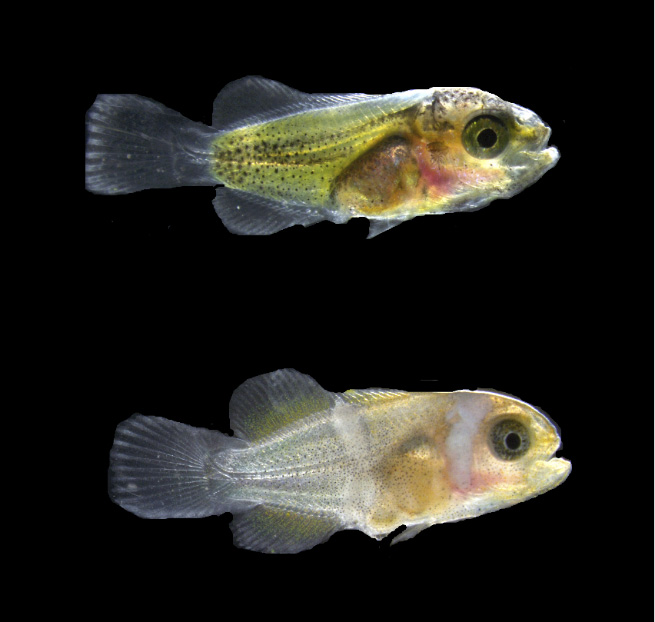Thyroid hormones regulate the formation and environmental plasticity of white bars in clownfishes
- 作者:Salis P, Roux N, Huang D, Marcionetti A, Mouginot P, Reynaud M, Salles O, Salamin N, Pujol B, Parich
- 期刊: Proc Natl Acad Sci USA (2021) 118(23): e2101634118. DOI: 10.1073/pnas.2101634118 https://www.pnas.org/content/118/23/e2101634118.long
Title: Thyroid hormones accelerate the development of white bars in clownfish larvae
Caption: Clownfish larvae treated with thyroid hormones formed a higher number of stripes at an earlier stage of development, compared to control larvae that weren’t treated with thyroid hormones. The image shows a control clownfish larvae (top) and a larvae five days after it was given a dose of thyroid hormones (bottom).
Determining how plasticity of developmental traits responds to environmental conditions is a challenge that must combine evolutionary sciences, ecology, and developmental biology. During metamorphosis, fish alter their morphology and color pattern according to environmental cues. We observed that juvenile clownfish (Amphiprion percula) modulate the developmental timing of their adult white bar formation during metamorphosis depending on the sea anemone species in which they are recruited. We observed an earlier formation of white bars when clownfish developed with Stichodactyla gigantea (Sg) than with Heteractis magnifica (Hm). As these bars, composed of iridophores, form during metamorphosis, we hypothesized that timing of their development may be thyroid hormone (TH) dependent. We treated clownfish larvae with TH and found that white bars developed earlier than in control fish. We further observed higher TH levels, associated with rapid white bar formation, in juveniles recruited in Sg than in Hm, explaining the faster white bar formation. Transcriptomic analysis of Sg recruits revealed higher expression of duox, a dual oxidase implicated in TH production as compared to Hm recruits. Finally, we showed that duox is an essential regulator of iridophore pattern timing in zebrafish. Taken together, our results suggest that TH controls the timing of adult color pattern formation and that shifts in duox expression and TH levels are associated with ecological differences resulting in divergent ontogenetic trajectories in color pattern development.
